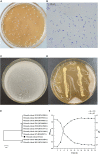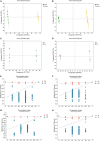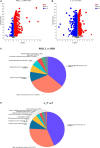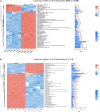Impact of Weissella cibaria BYL4.2 and its supernatants on Penicillium chrysogenum metabolism
- PMID: 36274712
- PMCID: PMC9581191
- DOI: 10.3389/fmicb.2022.983613
Impact of Weissella cibaria BYL4.2 and its supernatants on Penicillium chrysogenum metabolism
Abstract
Lactic acid bacteria (LAB) can produce a vast spectrum of antifungal metabolites to inhibit fungal growth. The purpose of this study was to elucidate the antifungal effect of isolated Weissella cibaria BYL4.2 on Penicillium chrysogenum, the antifungal activity of W. cibaria BYL4.2 against P. chrysogenum was evaluated by the superposition method, results showed that it had obviously antifungal activity against P. chrysogenum. Studying the probiotic properties of BYL4.2 and determining it as beneficial bacteria. Furtherly, different treatments were carried out to characterize the antifungal activity of cell-free supernatant (CFS) produced by W. cibaria BYL4.2, and it was shown that the CFS was pH-dependent, partly heat-sensitive, and was not influenced by proteinaceous treatment. The CFS of W. cibaria BYL4.2 was analyzed by high-performance liquid chromatography (HPLC) and found the highest content of lactic acid. Screening of metabolic markers by a non-targeted metabolomics approach based liquid chromatography-mass spectrometry (LC-MS). The results speculated that organic acid especially detected D-tartaric acid was the main antifungal substance of CFS, which could cause the down-regulation of metabolites in the ABC transporters pathway, thereby inhibiting the growth of P. chrysogenum. Therefore, this study may provide important information for the inhibitory mechanism of W. cibaria BYL4.2 on P. chrysogenum, and provide a basis for further research on the antifungal effect of Weissella.
Keywords: LAB; Penicillium chrysogenum; Weissella cibaria; antifungal effect; metabolome.
Copyright © 2022 Yao, Wang, Ma, Wu, Xu, Yu, Zhang and Zheng.
Conflict of interest statement
The authors declare that the research was conducted in the absence of any commercial or financial relationships that could be construed as a potential conflict of interest.
Figures








Similar articles
-
Antifungal activity of 2 lactic acid bacteria of the Weissella genus isolated from food.J Food Sci. 2011 Aug;76(6):M305-11. doi: 10.1111/j.1750-3841.2011.02257.x. Epub 2011 Jul 5. J Food Sci. 2011. PMID: 21729073
-
A polyphasic approach to characterize Weissella cibaria and Weissella confusa strains.J Appl Microbiol. 2020 Feb;128(2):500-512. doi: 10.1111/jam.14483. Epub 2019 Oct 25. J Appl Microbiol. 2020. PMID: 31602728
-
Antifungal activity of strains of lactic acid bacteria isolated from a semolina ecosystem against Penicillium roqueforti, Aspergillus niger and Endomyces fibuliger contaminating bakery products.Syst Appl Microbiol. 2009 Sep;32(6):438-48. doi: 10.1016/j.syapm.2009.01.004. Epub 2009 Feb 24. Syst Appl Microbiol. 2009. PMID: 19243908
-
Bio-protective potential of lactic acid bacteria isolated from fermented wax gourd.Folia Microbiol (Praha). 2012 Mar;57(2):99-105. doi: 10.1007/s12223-012-0101-1. Epub 2012 Feb 4. Folia Microbiol (Praha). 2012. PMID: 22307833
-
The impacts of antimicrobial and antifungal activity of cell-free supernatants from lactic acid bacteria in vitro and foods.Compr Rev Food Sci Food Saf. 2022 Jan;21(1):604-641. doi: 10.1111/1541-4337.12872. Epub 2021 Dec 14. Compr Rev Food Sci Food Saf. 2022. PMID: 34907656 Review.
Cited by
-
The Weissella and Periweissella genera: up-to-date taxonomy, ecology, safety, biotechnological, and probiotic potential.Front Microbiol. 2023 Dec 11;14:1289937. doi: 10.3389/fmicb.2023.1289937. eCollection 2023. Front Microbiol. 2023. PMID: 38169702 Free PMC article. Review.
-
Genomic insights into Penicillium chrysogenum adaptation to subseafloor sedimentary environments.BMC Genomics. 2024 Jan 2;25(1):4. doi: 10.1186/s12864-023-09921-1. BMC Genomics. 2024. PMID: 38166640 Free PMC article.
-
Metabolomic profiling and antibacterial efficacy of probiotic-derived cell-free supernatant encapsulated in nanostructured lipid carriers against canine multidrug-resistant bacteria.Front Vet Sci. 2025 Jan 3;11:1525897. doi: 10.3389/fvets.2024.1525897. eCollection 2024. Front Vet Sci. 2025. PMID: 39830167 Free PMC article.
References
-
- Buddhala C., Prentice H., Wu J.-Y. (2012). Modes of Action of Taurine and Granulocyte Colony-stimulating Factor in Neuroprotection. J. Exp. Clin. Med. 4 1–7. 10.1016/j.jecm.2011.11.001 - DOI
-
- Chen H., Ju H., Wang Y., Du G., Yan X., Cui Y., et al. (2021). Antifungal activity and mode of action of lactic acid bacteria isolated from kefir against Penicillium expansum. Food Control 130:108274. 10.1016/j.foodcont.2021.108274 - DOI
LinkOut - more resources
Full Text Sources
Other Literature Sources
Miscellaneous

